Marketing And Business Strategy Assignment
VerifiedAdded on 2022/08/21
|7
|1477
|12
AI Summary
Contribute Materials
Your contribution can guide someone’s learning journey. Share your
documents today.
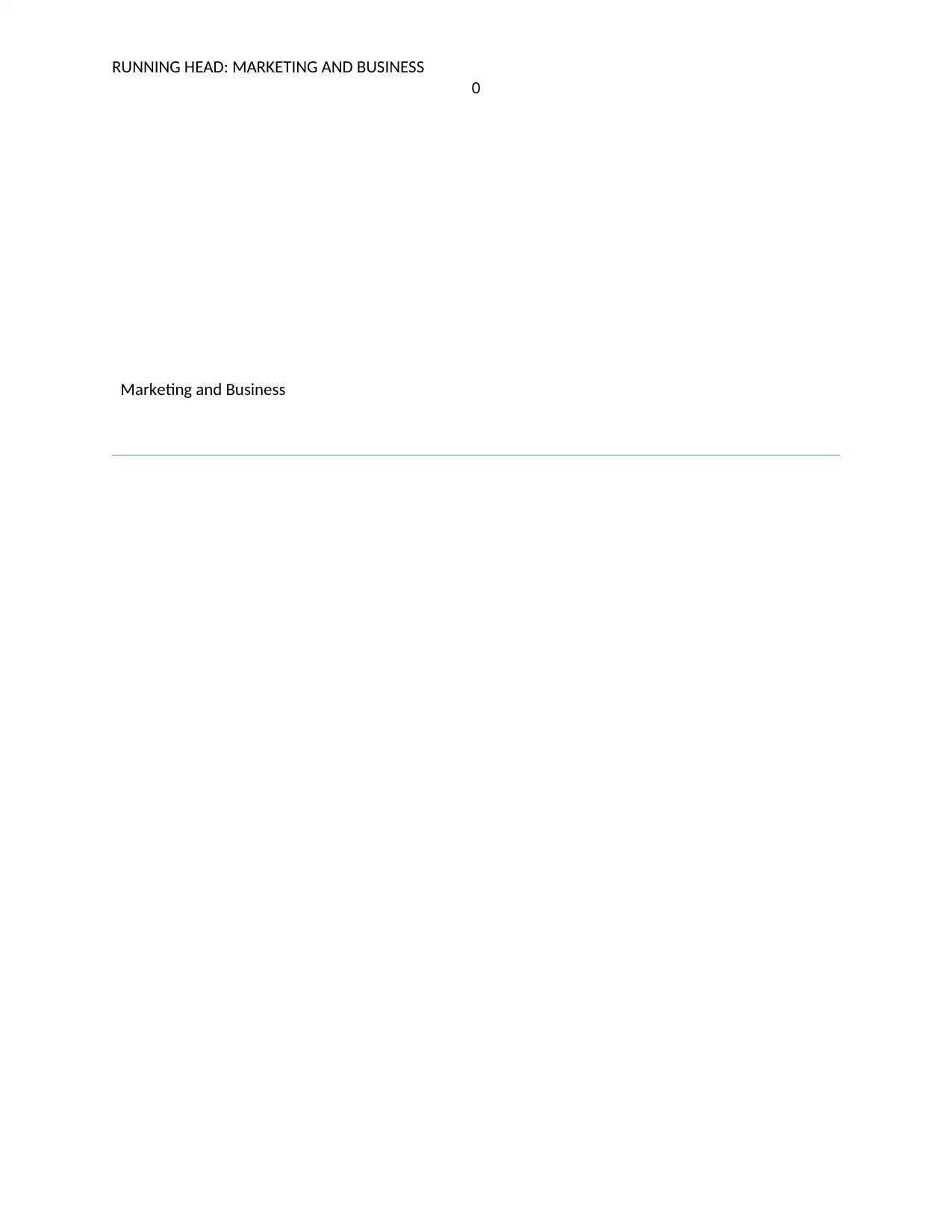
RUNNING HEAD: MARKETING AND BUSINESS
0
Marketing and Business
0
Marketing and Business
Secure Best Marks with AI Grader
Need help grading? Try our AI Grader for instant feedback on your assignments.
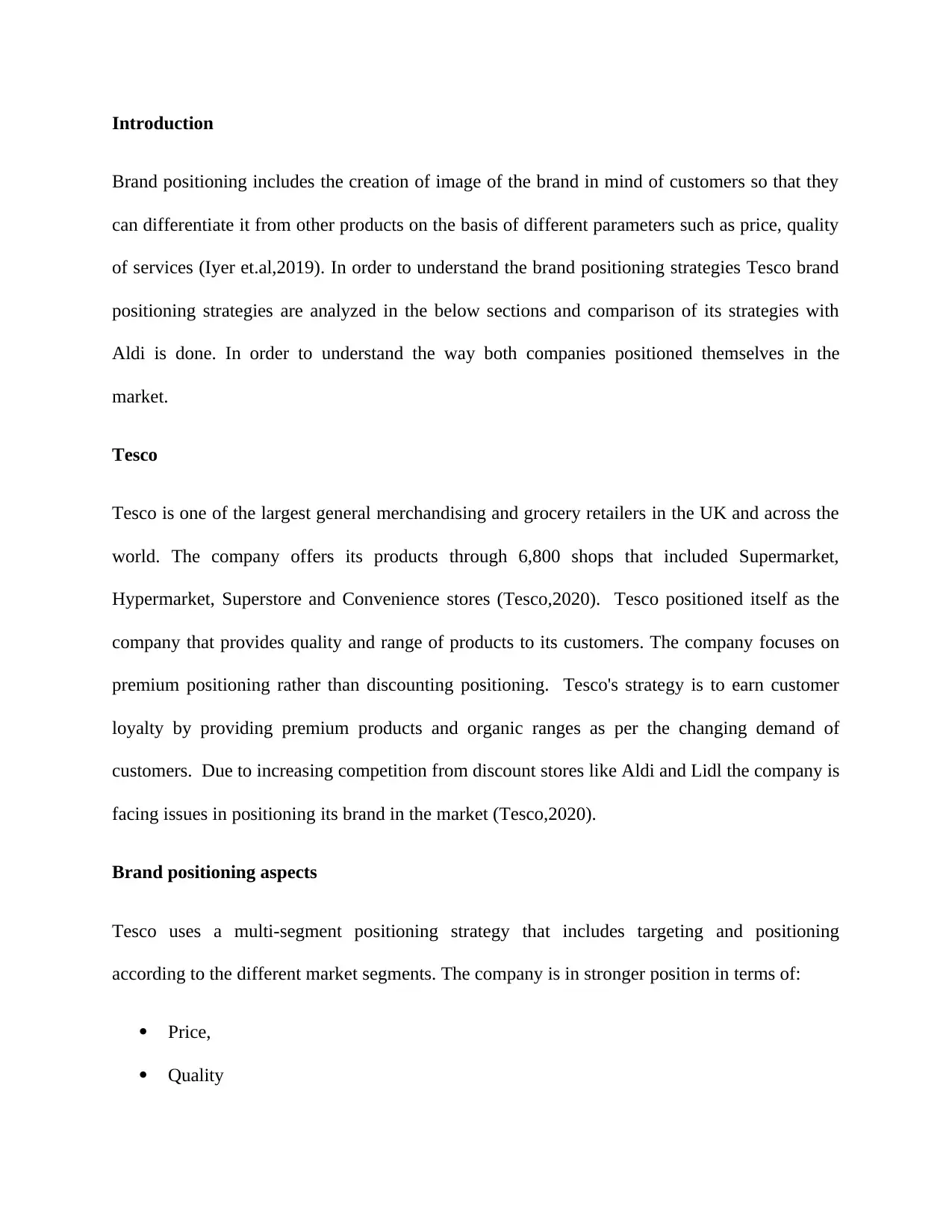
Introduction
Brand positioning includes the creation of image of the brand in mind of customers so that they
can differentiate it from other products on the basis of different parameters such as price, quality
of services (Iyer et.al,2019). In order to understand the brand positioning strategies Tesco brand
positioning strategies are analyzed in the below sections and comparison of its strategies with
Aldi is done. In order to understand the way both companies positioned themselves in the
market.
Tesco
Tesco is one of the largest general merchandising and grocery retailers in the UK and across the
world. The company offers its products through 6,800 shops that included Supermarket,
Hypermarket, Superstore and Convenience stores (Tesco,2020). Tesco positioned itself as the
company that provides quality and range of products to its customers. The company focuses on
premium positioning rather than discounting positioning. Tesco's strategy is to earn customer
loyalty by providing premium products and organic ranges as per the changing demand of
customers. Due to increasing competition from discount stores like Aldi and Lidl the company is
facing issues in positioning its brand in the market (Tesco,2020).
Brand positioning aspects
Tesco uses a multi-segment positioning strategy that includes targeting and positioning
according to the different market segments. The company is in stronger position in terms of:
Price,
Quality
Brand positioning includes the creation of image of the brand in mind of customers so that they
can differentiate it from other products on the basis of different parameters such as price, quality
of services (Iyer et.al,2019). In order to understand the brand positioning strategies Tesco brand
positioning strategies are analyzed in the below sections and comparison of its strategies with
Aldi is done. In order to understand the way both companies positioned themselves in the
market.
Tesco
Tesco is one of the largest general merchandising and grocery retailers in the UK and across the
world. The company offers its products through 6,800 shops that included Supermarket,
Hypermarket, Superstore and Convenience stores (Tesco,2020). Tesco positioned itself as the
company that provides quality and range of products to its customers. The company focuses on
premium positioning rather than discounting positioning. Tesco's strategy is to earn customer
loyalty by providing premium products and organic ranges as per the changing demand of
customers. Due to increasing competition from discount stores like Aldi and Lidl the company is
facing issues in positioning its brand in the market (Tesco,2020).
Brand positioning aspects
Tesco uses a multi-segment positioning strategy that includes targeting and positioning
according to the different market segments. The company is in stronger position in terms of:
Price,
Quality
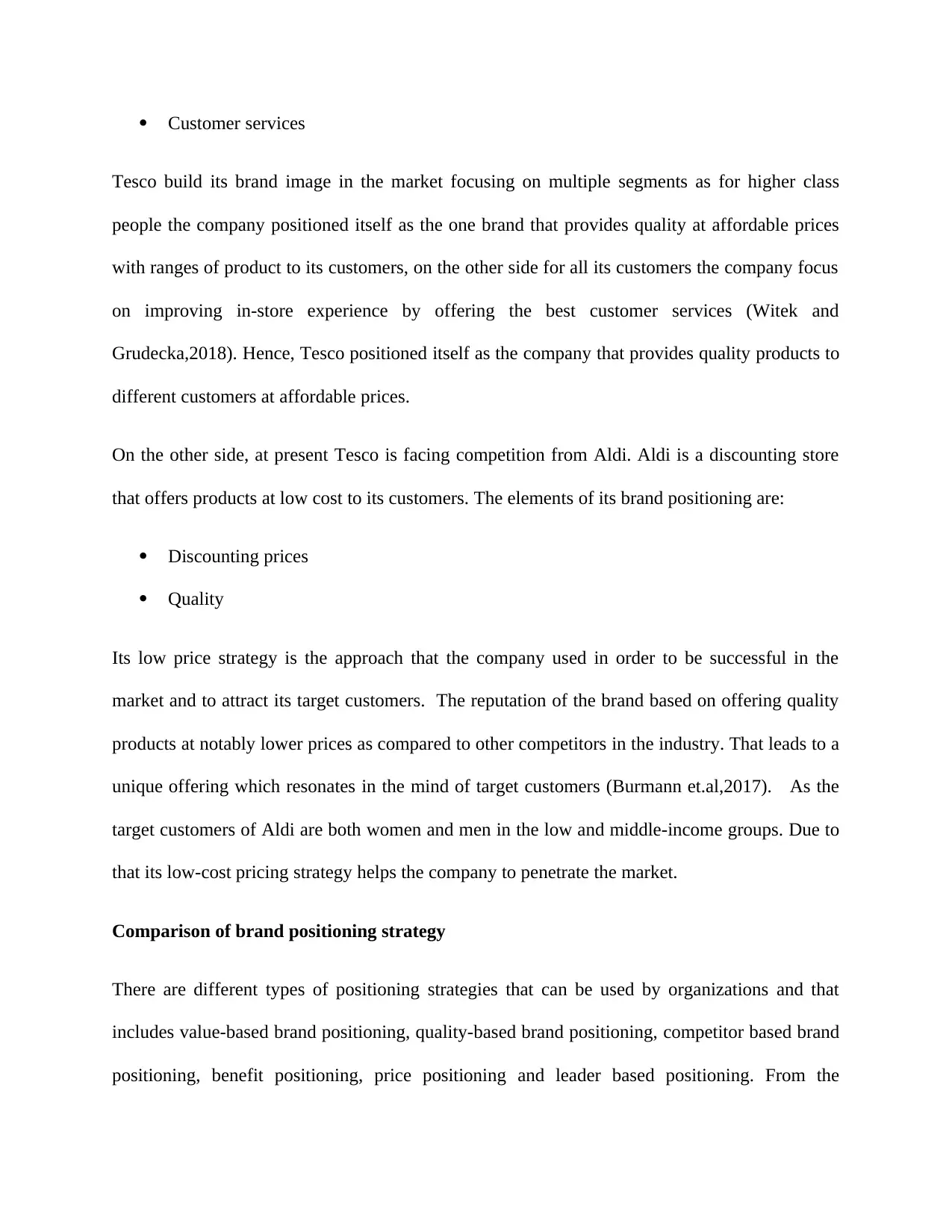
Customer services
Tesco build its brand image in the market focusing on multiple segments as for higher class
people the company positioned itself as the one brand that provides quality at affordable prices
with ranges of product to its customers, on the other side for all its customers the company focus
on improving in-store experience by offering the best customer services (Witek and
Grudecka,2018). Hence, Tesco positioned itself as the company that provides quality products to
different customers at affordable prices.
On the other side, at present Tesco is facing competition from Aldi. Aldi is a discounting store
that offers products at low cost to its customers. The elements of its brand positioning are:
Discounting prices
Quality
Its low price strategy is the approach that the company used in order to be successful in the
market and to attract its target customers. The reputation of the brand based on offering quality
products at notably lower prices as compared to other competitors in the industry. That leads to a
unique offering which resonates in the mind of target customers (Burmann et.al,2017). As the
target customers of Aldi are both women and men in the low and middle-income groups. Due to
that its low-cost pricing strategy helps the company to penetrate the market.
Comparison of brand positioning strategy
There are different types of positioning strategies that can be used by organizations and that
includes value-based brand positioning, quality-based brand positioning, competitor based brand
positioning, benefit positioning, price positioning and leader based positioning. From the
Tesco build its brand image in the market focusing on multiple segments as for higher class
people the company positioned itself as the one brand that provides quality at affordable prices
with ranges of product to its customers, on the other side for all its customers the company focus
on improving in-store experience by offering the best customer services (Witek and
Grudecka,2018). Hence, Tesco positioned itself as the company that provides quality products to
different customers at affordable prices.
On the other side, at present Tesco is facing competition from Aldi. Aldi is a discounting store
that offers products at low cost to its customers. The elements of its brand positioning are:
Discounting prices
Quality
Its low price strategy is the approach that the company used in order to be successful in the
market and to attract its target customers. The reputation of the brand based on offering quality
products at notably lower prices as compared to other competitors in the industry. That leads to a
unique offering which resonates in the mind of target customers (Burmann et.al,2017). As the
target customers of Aldi are both women and men in the low and middle-income groups. Due to
that its low-cost pricing strategy helps the company to penetrate the market.
Comparison of brand positioning strategy
There are different types of positioning strategies that can be used by organizations and that
includes value-based brand positioning, quality-based brand positioning, competitor based brand
positioning, benefit positioning, price positioning and leader based positioning. From the
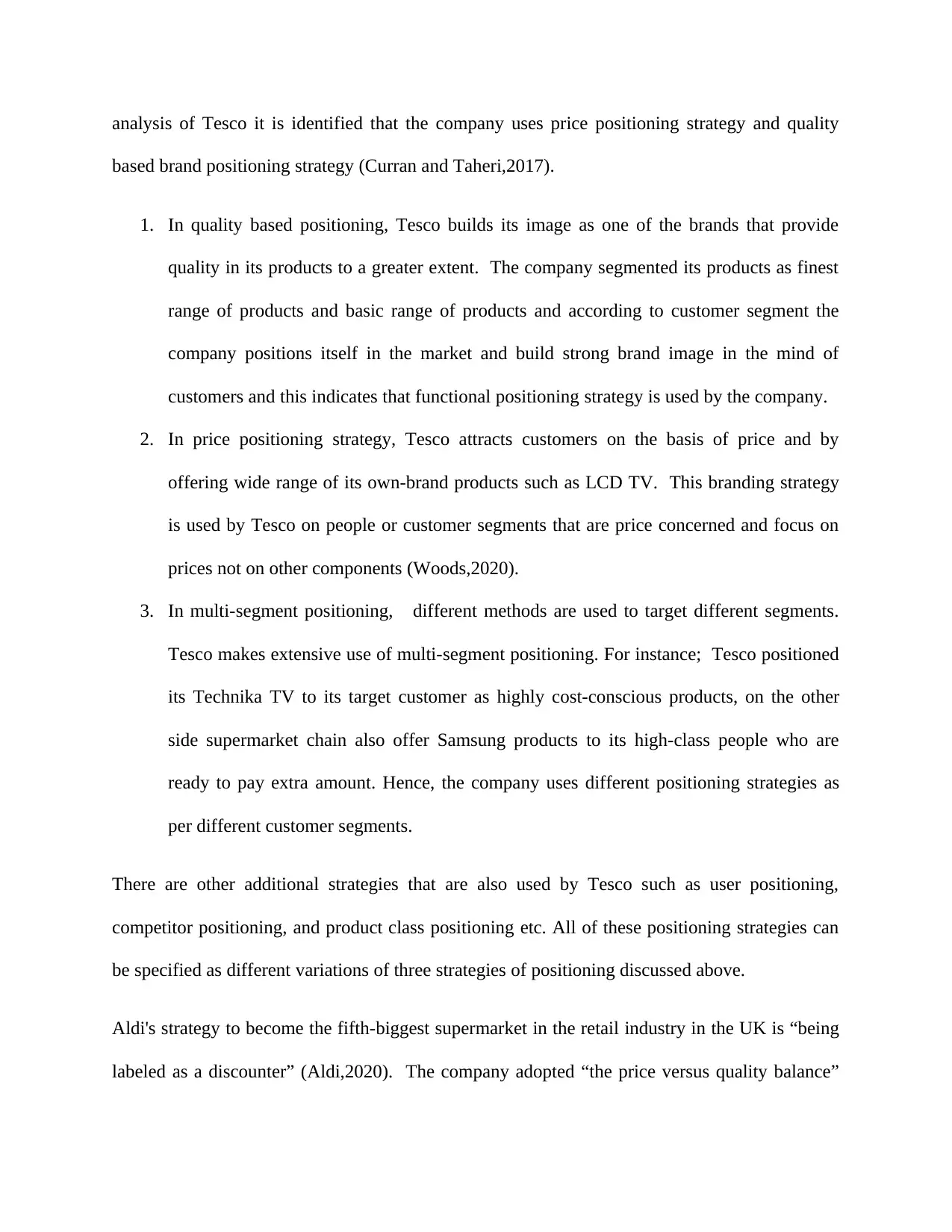
analysis of Tesco it is identified that the company uses price positioning strategy and quality
based brand positioning strategy (Curran and Taheri,2017).
1. In quality based positioning, Tesco builds its image as one of the brands that provide
quality in its products to a greater extent. The company segmented its products as finest
range of products and basic range of products and according to customer segment the
company positions itself in the market and build strong brand image in the mind of
customers and this indicates that functional positioning strategy is used by the company.
2. In price positioning strategy, Tesco attracts customers on the basis of price and by
offering wide range of its own-brand products such as LCD TV. This branding strategy
is used by Tesco on people or customer segments that are price concerned and focus on
prices not on other components (Woods,2020).
3. In multi-segment positioning, different methods are used to target different segments.
Tesco makes extensive use of multi-segment positioning. For instance; Tesco positioned
its Technika TV to its target customer as highly cost-conscious products, on the other
side supermarket chain also offer Samsung products to its high-class people who are
ready to pay extra amount. Hence, the company uses different positioning strategies as
per different customer segments.
There are other additional strategies that are also used by Tesco such as user positioning,
competitor positioning, and product class positioning etc. All of these positioning strategies can
be specified as different variations of three strategies of positioning discussed above.
Aldi's strategy to become the fifth-biggest supermarket in the retail industry in the UK is “being
labeled as a discounter” (Aldi,2020). The company adopted “the price versus quality balance”
based brand positioning strategy (Curran and Taheri,2017).
1. In quality based positioning, Tesco builds its image as one of the brands that provide
quality in its products to a greater extent. The company segmented its products as finest
range of products and basic range of products and according to customer segment the
company positions itself in the market and build strong brand image in the mind of
customers and this indicates that functional positioning strategy is used by the company.
2. In price positioning strategy, Tesco attracts customers on the basis of price and by
offering wide range of its own-brand products such as LCD TV. This branding strategy
is used by Tesco on people or customer segments that are price concerned and focus on
prices not on other components (Woods,2020).
3. In multi-segment positioning, different methods are used to target different segments.
Tesco makes extensive use of multi-segment positioning. For instance; Tesco positioned
its Technika TV to its target customer as highly cost-conscious products, on the other
side supermarket chain also offer Samsung products to its high-class people who are
ready to pay extra amount. Hence, the company uses different positioning strategies as
per different customer segments.
There are other additional strategies that are also used by Tesco such as user positioning,
competitor positioning, and product class positioning etc. All of these positioning strategies can
be specified as different variations of three strategies of positioning discussed above.
Aldi's strategy to become the fifth-biggest supermarket in the retail industry in the UK is “being
labeled as a discounter” (Aldi,2020). The company adopted “the price versus quality balance”
Secure Best Marks with AI Grader
Need help grading? Try our AI Grader for instant feedback on your assignments.
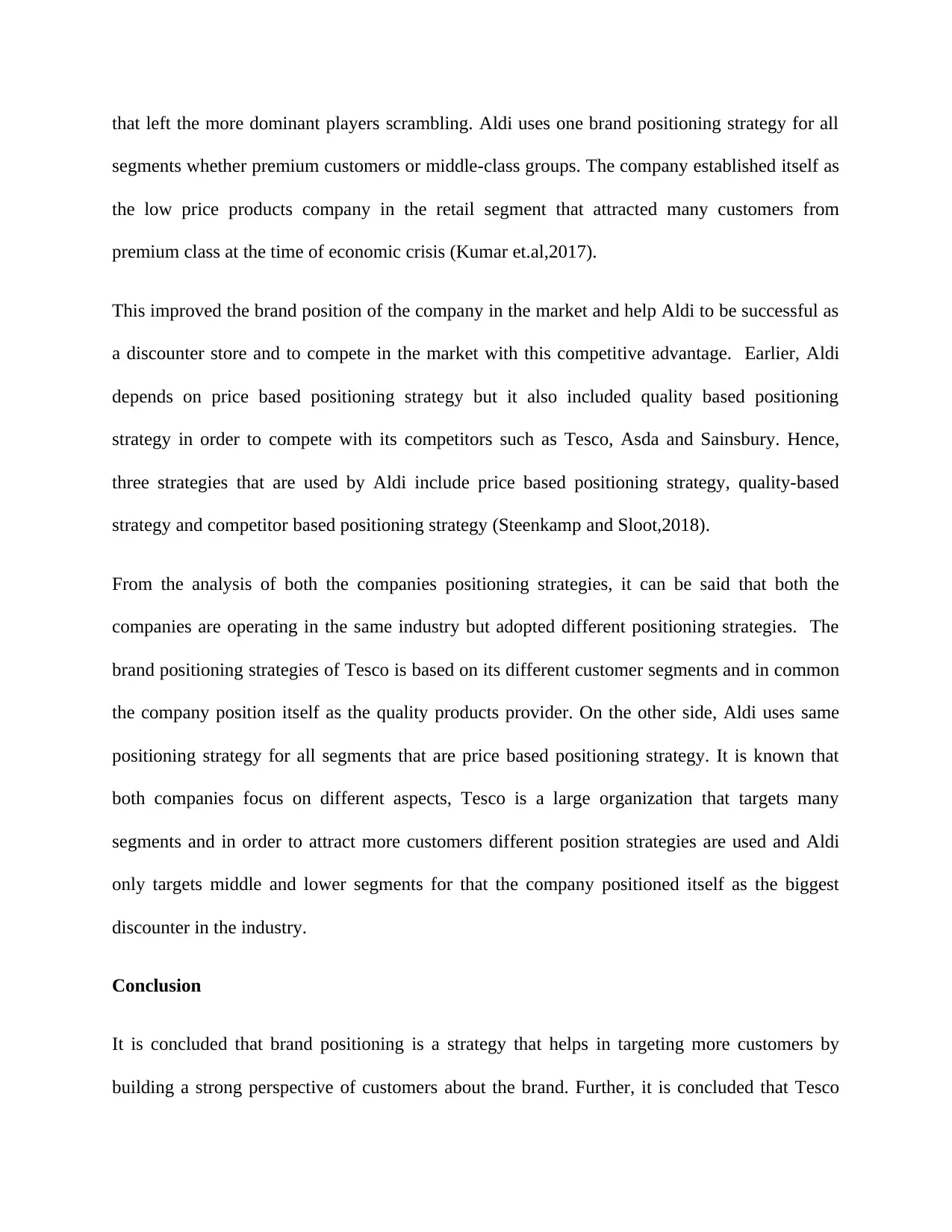
that left the more dominant players scrambling. Aldi uses one brand positioning strategy for all
segments whether premium customers or middle-class groups. The company established itself as
the low price products company in the retail segment that attracted many customers from
premium class at the time of economic crisis (Kumar et.al,2017).
This improved the brand position of the company in the market and help Aldi to be successful as
a discounter store and to compete in the market with this competitive advantage. Earlier, Aldi
depends on price based positioning strategy but it also included quality based positioning
strategy in order to compete with its competitors such as Tesco, Asda and Sainsbury. Hence,
three strategies that are used by Aldi include price based positioning strategy, quality-based
strategy and competitor based positioning strategy (Steenkamp and Sloot,2018).
From the analysis of both the companies positioning strategies, it can be said that both the
companies are operating in the same industry but adopted different positioning strategies. The
brand positioning strategies of Tesco is based on its different customer segments and in common
the company position itself as the quality products provider. On the other side, Aldi uses same
positioning strategy for all segments that are price based positioning strategy. It is known that
both companies focus on different aspects, Tesco is a large organization that targets many
segments and in order to attract more customers different position strategies are used and Aldi
only targets middle and lower segments for that the company positioned itself as the biggest
discounter in the industry.
Conclusion
It is concluded that brand positioning is a strategy that helps in targeting more customers by
building a strong perspective of customers about the brand. Further, it is concluded that Tesco
segments whether premium customers or middle-class groups. The company established itself as
the low price products company in the retail segment that attracted many customers from
premium class at the time of economic crisis (Kumar et.al,2017).
This improved the brand position of the company in the market and help Aldi to be successful as
a discounter store and to compete in the market with this competitive advantage. Earlier, Aldi
depends on price based positioning strategy but it also included quality based positioning
strategy in order to compete with its competitors such as Tesco, Asda and Sainsbury. Hence,
three strategies that are used by Aldi include price based positioning strategy, quality-based
strategy and competitor based positioning strategy (Steenkamp and Sloot,2018).
From the analysis of both the companies positioning strategies, it can be said that both the
companies are operating in the same industry but adopted different positioning strategies. The
brand positioning strategies of Tesco is based on its different customer segments and in common
the company position itself as the quality products provider. On the other side, Aldi uses same
positioning strategy for all segments that are price based positioning strategy. It is known that
both companies focus on different aspects, Tesco is a large organization that targets many
segments and in order to attract more customers different position strategies are used and Aldi
only targets middle and lower segments for that the company positioned itself as the biggest
discounter in the industry.
Conclusion
It is concluded that brand positioning is a strategy that helps in targeting more customers by
building a strong perspective of customers about the brand. Further, it is concluded that Tesco
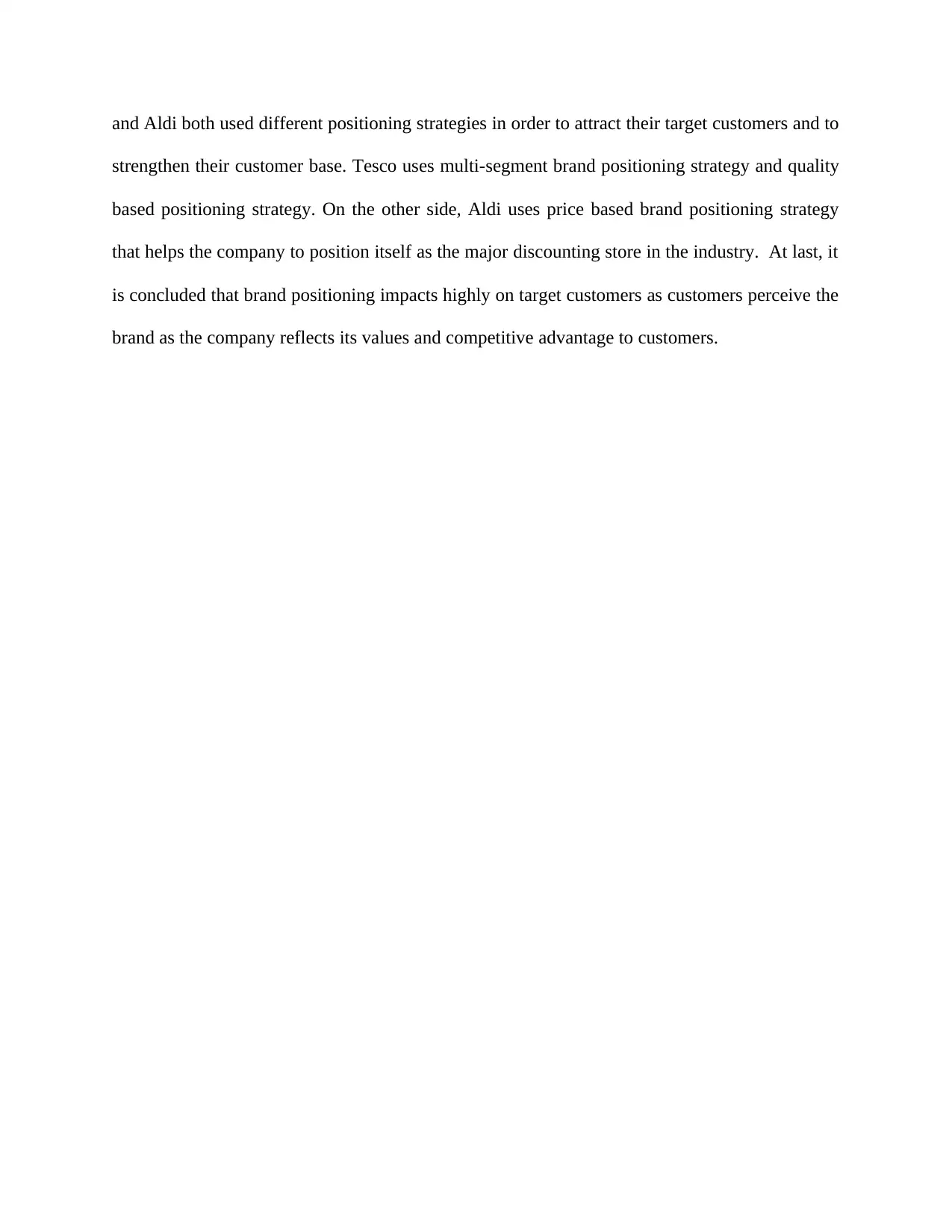
and Aldi both used different positioning strategies in order to attract their target customers and to
strengthen their customer base. Tesco uses multi-segment brand positioning strategy and quality
based positioning strategy. On the other side, Aldi uses price based brand positioning strategy
that helps the company to position itself as the major discounting store in the industry. At last, it
is concluded that brand positioning impacts highly on target customers as customers perceive the
brand as the company reflects its values and competitive advantage to customers.
strengthen their customer base. Tesco uses multi-segment brand positioning strategy and quality
based positioning strategy. On the other side, Aldi uses price based brand positioning strategy
that helps the company to position itself as the major discounting store in the industry. At last, it
is concluded that brand positioning impacts highly on target customers as customers perceive the
brand as the company reflects its values and competitive advantage to customers.

References
Aldi,2020. About us. Accessed From: https://aldi.com/
Burmann, C., Riley, N.M., Halaszovich, T. and Schade, M., 2017. Strategic Brand Management.
In Identity-Based Brand Management (pp. 91-172). Springer Gabler, Wiesbaden.
Curran, R. and Taheri, B., 2017. 6 Branding and Brand Communications. Marketing
Communications: An advertising, promotion and branding perspective, pp.77-92.
Iyer, P., Davari, A., Zolfagharian, M. and Paswan, A., 2019. Market orientation, positioning
strategy, and brand performance. Industrial Marketing Management, 81, pp.16-29.
Kumar, V., Anand, A. and Song, H., 2017. Future of retailer profitability: An organizing
framework. Journal of Retailing, 93(1), pp.96-119.
Steenkamp, J.B. and Sloot, L., 2018. Retail disruptors: The spectacular rise and impact of the
hard discounters. Kogan Page Publishers.
Tesco,2020. About us. Accessed From: https://www.tescoplc.com/
Witek-Hajduk, M.K., and Grudecka, A., 2018. Positioning strategies of retailers’ brands in the
emerging market–a cluster analysis. International Journal of Emerging Markets.
Woods, P., 2020. Brand Positioning. The Brand Strategy Canvas (pp. 67-86). Apress, Berkeley,
CA.
Aldi,2020. About us. Accessed From: https://aldi.com/
Burmann, C., Riley, N.M., Halaszovich, T. and Schade, M., 2017. Strategic Brand Management.
In Identity-Based Brand Management (pp. 91-172). Springer Gabler, Wiesbaden.
Curran, R. and Taheri, B., 2017. 6 Branding and Brand Communications. Marketing
Communications: An advertising, promotion and branding perspective, pp.77-92.
Iyer, P., Davari, A., Zolfagharian, M. and Paswan, A., 2019. Market orientation, positioning
strategy, and brand performance. Industrial Marketing Management, 81, pp.16-29.
Kumar, V., Anand, A. and Song, H., 2017. Future of retailer profitability: An organizing
framework. Journal of Retailing, 93(1), pp.96-119.
Steenkamp, J.B. and Sloot, L., 2018. Retail disruptors: The spectacular rise and impact of the
hard discounters. Kogan Page Publishers.
Tesco,2020. About us. Accessed From: https://www.tescoplc.com/
Witek-Hajduk, M.K., and Grudecka, A., 2018. Positioning strategies of retailers’ brands in the
emerging market–a cluster analysis. International Journal of Emerging Markets.
Woods, P., 2020. Brand Positioning. The Brand Strategy Canvas (pp. 67-86). Apress, Berkeley,
CA.
1 out of 7
Related Documents
Your All-in-One AI-Powered Toolkit for Academic Success.
+13062052269
info@desklib.com
Available 24*7 on WhatsApp / Email
![[object Object]](/_next/static/media/star-bottom.7253800d.svg)
Unlock your academic potential
© 2024 | Zucol Services PVT LTD | All rights reserved.





